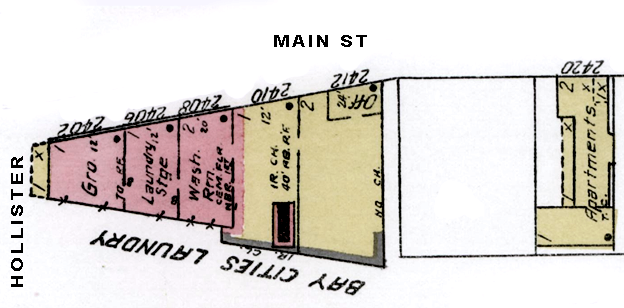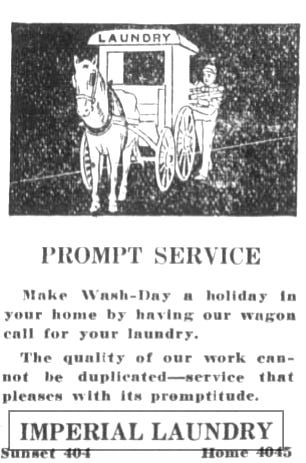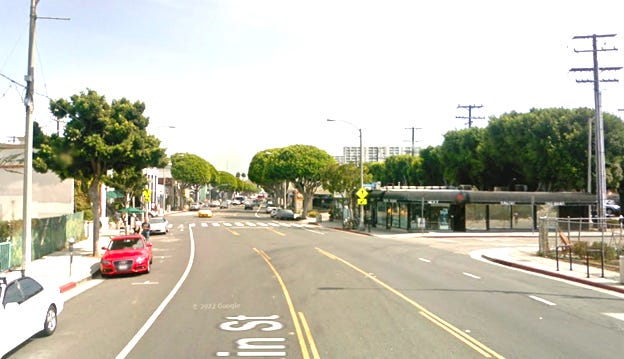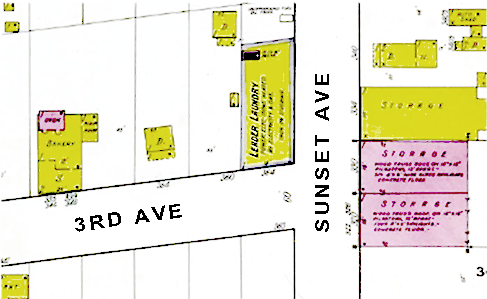In 1908, a steam laundry is constructed on the west side of Main St at Hollister. In 1919, the abandoned laundry is converted to an automobile garage. In 1926, the garage is demolished to make way for the widening of Main St.
Before Main St Widening
[1907 to 1908] Citizens Co-Operative Laundry
In 1907,1 the Citizens Co-Operative Laundry Company is formed2 to establish a steam laundry.3 A vacant lot at the SWC Main & Hollister, where the old Santa Fe rail tracks leave Main St, is acquired.
Steam laundry equipment,4 purchased from Cincinnati, is conveniently delivered at the site by train. Construction of the plant begins in April 1907. An onsite generator (burning oil) supplies electricity for the machinery and lighting. The washing water is obtained from an on-site artesian well.
[1908 to 1910] Bay Cities Laundry
In 1908, entrepreneur E.T. Howe (1858 – 1911) and laundryman C.S. Paul take over the defunct5 Citizens Co-Operative Laundry Company plant6 and open Bay Cities Laundry.7
The laundry service is “rough dry work” - items are washed, starched, and dried, but not ironed.8 Laundry is picked up from and delivered to customer’s homes. William H. Carter (1879 – 1936), later mayor of Santa Monica, becomes the laundry manager.
[1910 to 1916] Imperial Laundry
In 1910, T.H. Leavell (1866 – 1934),9 L.R. Chenoweth, and K.A. Miller form Imperial Laundry Company10 and acquire the Main & Hollister Bay Cities Laundry.
In 1916,11 Imperial Laundry buys Leader Laundry12 of Venice. Imperial Laundry abandons the Main & Hollister site - moving all of the plant and operations to the Leader Laundry site in Venice. Leavell heads the consolidated Imperial Laundry, which employs 35 people serving Santa Monica and Venice.13
[1919 to 1926] Hollister Garage
In 1919, Day and Day convert the vacant Imperial Laundry to the Hollister Garage. The garage is used for auto storage, auto servicing and repair, a tow service, and a taxi service. G.W. Donaldson and E.L. Moore own and operate the automobile servicing and repair business.
After Main St Widening
[1926] Demolition
In 1926, the Hollister Garage is demolished as a part of the Main St widening project. The widening of Main Street from 40 feet to 80 feet begins at Hollister and continues (3,000 feet) south down the west side of Main St to the City border just past Marine.
The Main & Hollister site remains vacant until 1936, when H.C. Cook opens a gas station.
The current buildings on the site originate from a 1960 Fuller Auto Body Repair & Paint shop.
Until 1897, Santa Monica residents send their laundry to Los Angeles (Los Angeles Steam Laundry founded in 1885). The Santa Monica Steam Laundry opens in 1897. The Ocean Park Steam Laundry opens at Main & Hill in 1906.
Citizens Co-Operative Laundry Company is formed in 1907 with Dr. J.P. Stanwood (president), Lee H. Young (vice-president), T.M. Meldrum (treasurer), and W.R.Porter (secretary) and capital of $25,000 - 5,000 shares at $5 each. Stock subscribers receive back their stock purchase price through a 10% discount on laundry bills - up to the amount of stock they purchased.
Steam laundries are industrial operations, different from hand laundries. Called steam laundries not because they used steam to clean clothes, but because they originally used steam engines to power the washing machinery - although exhaust steam is used to heat the washing water and dry the laundry. Electricity soon replaces steam power.
Drivers working on commission pick up bundles of soiled clothes at customers’ homes. Once delivered to the laundry, the bundles are weighed and sent to the sorting room.
Skilled sorters break open each bundle, list each piece with a typewriter-like machine, mark them with indelible ink visible only in infra-red light, and separate them into three groups: white clothes, colored, and ‘fugitives’ whose colors run.
The items are loaded into large washing machines that move through several suds and rinse cycles. Then on to large, sieve-like cylinders for drying. Finally, using the ink markings under infra-red light, the original bundles are reassembled, packaged, and sent, with the bill, to the delivery trucks.
What becomes of Citizens Co-Operative Laundry? The contractor, Nelson, is making progress on the laundry in July 1907. But it seems that Citizens Co-Operative Laundry never opens - there is no mention of hiring or a grand opening in the local papers.
The laundry does not occupy the whole building. At the Hollister end of the building (2402 Main St) there is a grocery store.
The Main & Hollister 1908 to 1910 Bay Cities Laundry is not associated with the 1925 Bay Cities Laundry in Venice.
Laundries charge by weight and type of service. There are four general classes of laundry service:-
Bundle Work - the first class of work done by laundries. It includes shirts, collars, underwear, ladies’ wear, and all other wearing apparel. It also includes family flat work. Flat work is sheets, table cloths, towels, napkins, etc. ironed by large roller flat work ironers.
Rough Dry Work - wearing apparel that is washed, starched and dried, but not ironed. Many laundries include family flat work on the rough dry list, completely finish it at the same price per pound as the wearing apparel, and classify it as rough dry.
Wholesale Flat Work - large lot flat work from hotels, restaurants, boarding houses, etc.
Wet Wash - general family washing that is washed and returned just wet enough for hanging on the family clothesline.
Thomas Harrison Leavell (1866 – 1934). Leavell is a farmer in OH and moves to WA. There in 1897, he marries Minnie E. Fry (1879 - 1937), and they have a daughter, Pearl E. Leavell. In 1910, the family leaves WA and comes to Santa Monica (living at 126 Pacific). Leavell operates of the Imperial Laundry from 1910 to 1917. By 1920, he is a deliveryman in the Sacramento area.
Imperial Laundry is not associated with the nearby Imperial Ice Company at 2435 Main St.
In 1916, the City of Venice passes a Laundry Ordinance that requires laundrymen outside of Venice and delivering to Venice to pay a license fee of $120 / year. The license fee for Venice laundrymen is $12 / year. In 1917, an appellate court rules that the Venice laundry ordinance is not legal.
Leader Laundry Company at 3rd Ave & Sunset Ave, Venice is opened by Abraham S. Reel (1843 – 1925) and Myron J. Carr (1878 - 1954) in 1913. Carr, a Venice City Trustee, becomes the sole owner in 1915. Carr sells Leader Laundry to the Imperial Laundry Company for $1,500 in 1916.
What becomes of Imperial Laundry? After 1917, there is no further mention of Imperial Laundry in the Santa Monica and Venice newspapers. By 1924, the 6 laundries in Santa Monica and Venice are: Bay Cities Laundry (V), Beach Laundry Service (V), Crescent Soft Water Laundry (SM), Domestic Hand Laundry (SM), Pacific Soft Water Laundry (SM), and Santa Monica Steam Laundry (SM).















